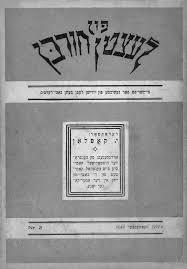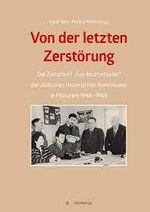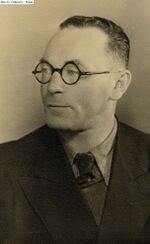File:1946 Kaplan.jpg
1946_Kaplan.jpg (187 × 269 pixels, file size: 7 KB, MIME type: image/jpeg)
Title
Fun letstn khurbn [From the Last Extermination]: Journal for the history of the Jewish people during the Nazi regime. Munich [Germany]: 1946-1948.
Abstract
"In December 1945 the "Central Committee for the Liberated Jews in Germany" (Tsentral komitet fun di bafrayte Yidn in der Amerikaner Zone) set up the Munich-based "Central Historical Commission" (Tsentral historishe komisye). Israel Kaplan, a teacher from Kovno, and Moshe Figenboim, an accountant, were appointed to head the Commission. Through their leadership (and much prodding), the Commission’s pool of employees and paid and unpaid volunteers collected 2,500 testimonies as well as 8,000 questionnaires filled out mainly in Yiddish, but also in Hebrew, Polish, Hungarian, and German ... With Hebrew-alphabet print sets and a printing machine, the Commission began publishing in 1946 a Yiddish-language journal entitled Fun letstn khurbn (From the Last Destruction). The journal’s primary purpose was to support documentation efforts by encouraging DPs to give testimony. ... The child survivors and their stories held a strong fascination with Kaplan, whose own child, Shalom Kaplan, survived the Holocaust in hiding and on the run. Under Kaplan’s guidance, the Historical Commission started a collection campaign in late 1946. Like the Historical Commission in Poland, the Munich commission developed special questionnaires and opened an essay contest for children writing about their Holocaust experiences. Hundreds of testimonies were collected from child survivors by the staff of the Central Historical Commission during its more than three years of existence ... For Kaplan, who was also the editor-in-chief of Fun letstn khurbn, children were a distinct group whose voice the world needed to hear. Starting with the second issue, Kaplan published a child’s testimony in each issue of Fun letstn khurbn. A total of eight testimonies were selected for publication between 1946 and 1948 ... The Commission was disbanded in 1948, and the materials it had gathered were transferred eventually to Yad Vashem."--Boaz Coen
About the Author
Israel Kaplan (1902-2003) was one of the founders of the systematic collecting of testimonies about the Holocaust and the documentation of the grim folklore of the Jews in ghettos and camps.
As early as August 1941, with the sealing off of the ghetto in Kaunas (Kovno), Kaplan undertook the assignment to surreptitiously record the goings - on in the ghetto. In February 1942, Kaplan was deported to the Riga ghetto. From there, he succeeded in transmitting to Kovno a detailed report of his circumstances and the fate of his group of 450 fellow deportees. Throughout his internments in a series of camps in Latvia, Lithuania, Poland, and Germany, and despite the personal dangers involved, Kaplan never ceased his clandestine documentation of the sayings and black humor of the tortured inmates and those going to their deaths.
Directly following the liberation, he began recording the testimonies of survivors and the collecting of documentation of the Holocaust that had just come to an end. Together with M.Y. Feigenbaum, he was among the founders of the "Tsentraler Historisher Komisye" [Yiddish: Central Historical Commission] that operated in conjunction with the "Central Committee of the Liberated Jews in the American Zone" of postwar Germany. Kaplan served as historiographer for the committee. He edited the journal, "Fun Letztn Khurbm" [Yiddish: From the last ruins], that represented the first collecting of Holocaust material from diverse places, that summed these up in an academic manner. (A total of ten collections were published, during the years 1946 - 1948.) Along with this, he brought out a significant collection of Jewish folklore from the camps: "Dos Folksmoyl in Natsi Klem" [The people's language in the Nazi vise], published in Muenchen (Munich) in 1949 and reissued in Israel by the Ghetto Fighters' House, in two editions (Jewish Folk-Expressions under the Nazi Yoke, 1982 and 1987).
The material collected by a network of local committees in the various DP camps was collected in Muenchen, and upon the establishment of the State of Israel was transferred to Jerusalem. There it formed the basis for Yad Vashem, Israel's Holocaust remembrance authority.
Israel Kaplan immigrated to Israel in early 1949. He participated in editing the "Yahadut Lita" [Hebrew: Lithuanian Jewry] memorial books and pursued his literary activities, primarily in Yiddish. His notable literary achievements included the Itsik Manger Prize. He wrote nine books that were published between the years 1964 - 1999. Shortly after his death in 2003, his article "Fun Folksmoyl un Mayns" [From the people's language and mine] was published.
File history
Click on a date/time to view the file as it appeared at that time.
| Date/Time | Thumbnail | Dimensions | User | Comment | |
|---|---|---|---|---|---|
| current | 09:44, 22 February 2022 |  | 187 × 269 (7 KB) | Gabriele Boccaccini (talk | contribs) |
You cannot overwrite this file.
File usage
There are no pages that use this file.


